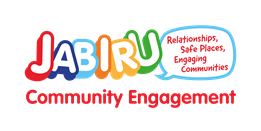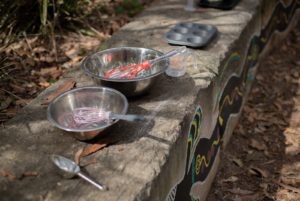Water Play: Guest Blog by the Jabiru Community Engagement team

The wonderful team at Jabiru community engagement at Zillmere have written a fantastic blog for us this week on the benefits of water play.
Jabiru are a community-based not-for-profit organisation which supports the community with development activities and emphasises a sense of belonging. This blog is great for families who want to engage in a fun summer activity at home with water to help develop play, language, fine motor and sensory skills.
If you are looking for a super easy way to keep children engaged and having fun at home this summer, look no further than water play.
Splashing and pouring, children seem to have an endless fascination with water and the way it feels and moves.
It is one of our favorite activities to set up in our playgroups and for good reason! While it is fun and engaging it also has many learning and developmental benefits for children.
Perhaps the best thing about it is that waterplay is open-ended, meaning there is no one right way for children to play.
This allows children to follow their interests and use their imagination. As children engage in water play they begin to understand and experiment with math and science concepts such as more/less, empty/full, before/after, greater than/less than, sink/float, the effects of force (pouring fast and slow), and changes in state (solid, liquid, gas).
It is also an effective way for children to develop hand/eye coordination through pouring, squeezing and squirting, fine motor skills through using small tools such as a pipette or a small spoon. As we talk to children about their play, there is a lot of new vocabulary to be learnt including bowl, measuring, jug, ladle, spoon, funnel.
At this time of heightened stress in our communities, sensory play with water is very calming for children and can therefore have a positive impact on children’s behaviour and sleep.
Maybe this type of play could be added into your new daily routine with your little ones. Water play can also provide a moment in the day for you to sit down and really connect with your little one while they play. If you can, take this simple water play set up outside or somewhere where you don’t have to perry about the mess, bring a comfy chair for yourself (maybe even that cup of coffee too) and sit back and observe your child’s interests, skills and what they are learning.
We hope these activities can be enjoyable and grounding for you as a parent too and bring you into the present moment as you watch your little one delight in water play!
Set up: can be as simple as you like it! Just take a container of water outside, fill up the bath anytime of the day, use the sink (stable step stool for children to comfortably reach the sink and towels for catching drips) or place a baking tray filled with water on a towel on the floor for tummy time with bubs. Add some jugs and cups of different sizes for tipping and pouring. Watch your little one splash and play!

What You Will Need:
- Plastic storage container or baking tray
- Plastic cups and jugs of different sizes
- Scoops or large spoons, ladle, a whisk
- Other bowls and containers such as ice cube trays and bowls to extend the play if desired
- Pipettes
- A couple of drops of food colouring
How To Set Up Water Play Across Different Ages And Stages:
- Babies: Place a baking tray filled with water on a towel on the floor for tummy time bubs.
- For toddlers: Take a container of water outside. Add in some plastic cups and jugs of different sizes for pouring
- For older toddlers and preschoolers: Add in some variations like pipettes, a large spoon or ladle, funnels, bottles, ice cube or muffin trays and bowls. This will add extra interest and allow older children to engage for longer as they make decisions about what tools they will use with the water and how they will use them. Having a few extra items out can also inspire some imaginative play – the water play set up might quickly turn into a tea party, or by adding in some natural treasures like leaves and rocks and flowers the children might create a ‘magic potion’.
Some Other Ideas To Try
- Fill up some cups with different coloured water and experiment with colouring mixing.
- Add coloured pom poms and spoons to make ‘pom pom soup’.
- Add toy cars and sponges to set up a toy car wash.
- Clean the baby dolls with bubbles and washcloths.
- Add some cold ice cubes, smelly lavender or herbs or ‘treasures’ that float or sink from around your home to add to the sensory exploration.
Notes
- Let children take the lead! When it comes to water play or any sensory play, children intuitively know what to do. Our role is to set it up and then sit, watch and provide support when needed.
- Letting children follow their instincts and play with water however they wish has enormous benefits in promoting independence and self esteem.
Safety Notes
Of course, all water activities with children require constant supervision so please adapt these ideas as needed to be safer for your own child’s age and abilities.
Learn more about Jabiru’s community engagement teams and the support they provide here .
